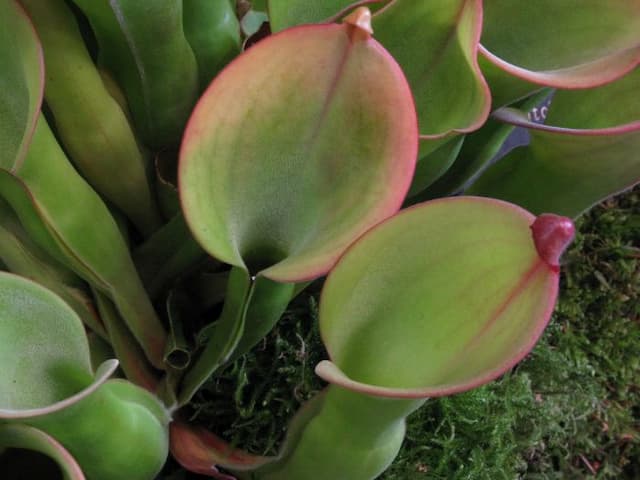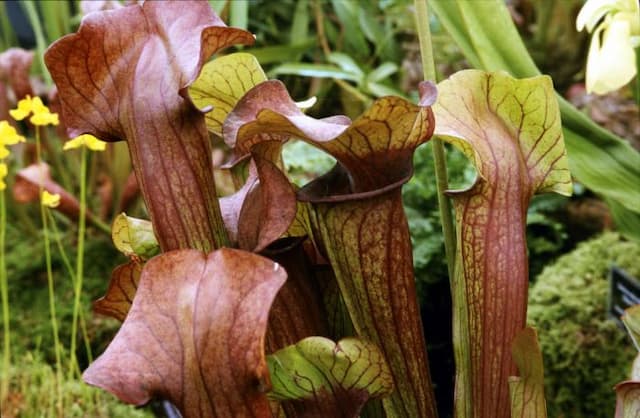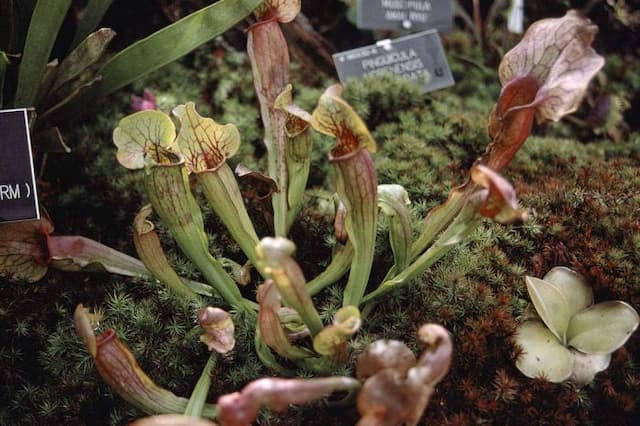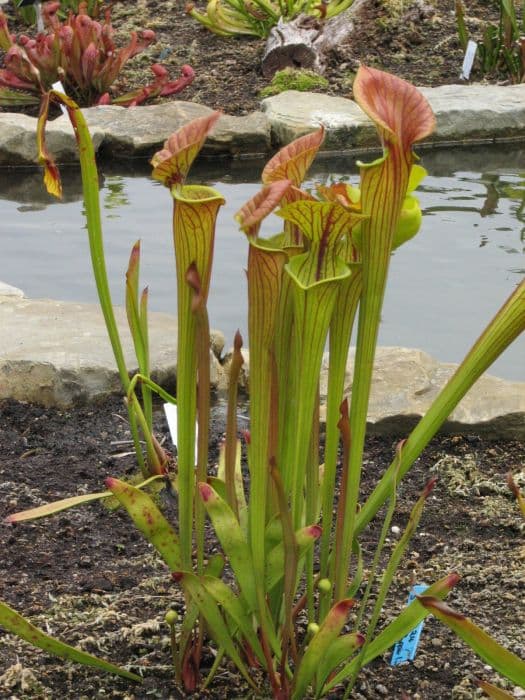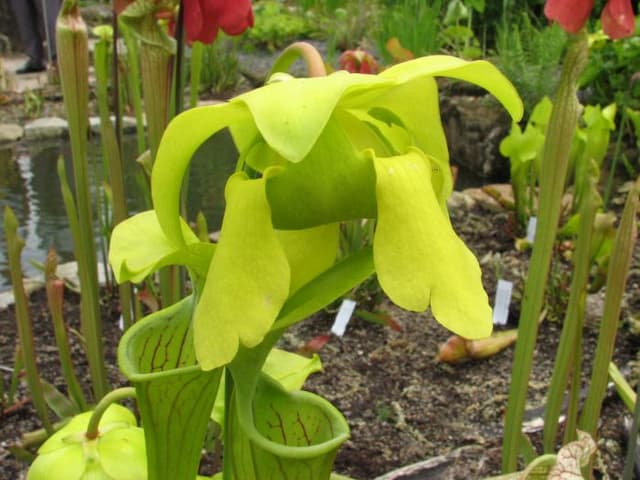Parrot Pitcher Plant Sarracenia psittacina

ABOUT
The plant known as the parrot pitcher is characterized by its unique and striking pitcher-like leaves, which have evolved to attract and capture insects. These leaves are tubular and feature a hood that helps prevent excess rain from diluting the digestive fluids inside. The pitchers showcase a variety of colors, typically ranging from green to red, and are often veined or spotted, enhancing their visual allure to prey. The mouth of each pitcher is a distinct feature that resembles the beak of a parrot, hence the name. This opening is where insects are drawn in, lured by the plant's nectar. The inside of the pitcher is slippery, and downward-pointing hairs make it difficult for trapped insects to escape. At the bottom of the pitcher, enzymes and bacteria break down the captured prey, allowing the plant to absorb essential nutrients. In addition to the carnivorous pitchers, the parrot pitcher plant also produces flowers. These blooms are generally fairly inconspicuous compared to the showy pitchers and grow on a separate stalk. The color of the flowers may vary but they often possess a subdued hue that contrasts with the bright pitchers. The overall appearance of the parrot pitcher plant is one of a curious and almost otherworldly organism, evolved to thrive in nutrient-poor environments where it compensates for the lack of soil nutrients with its insect-trapping capabilities. The combination of vibrant colors and unusual shapes makes this plant a fascinating specimen for both botanists and enthusiasts.
About this plant
 Names
NamesFamily
Sarraceniaceae
Synonyms
Parrot Pitcher Plant, Parrot's Pitcher Plant
Common names
Sarracenia pulchella, Chelonophyllum psittacinum, Sarracenia psittacina var. minor, Sarracenia minor var. okefenokeensis.
 Toxicity
ToxicityTo humans
The parrot pitcher plant is not known to be toxic to humans. There is no documented evidence of toxicity arising from handling or ingesting parts of the parrot pitcher plant. Therefore, it is not considered poisonous, and there are no known symptoms of poisoning from this plant to describe.
To pets
The parrot pitcher plant is also not considered toxic to pets. There is no specific information indicating that ingestion of this carnivorous plant by animals such as cats or dogs will lead to poisoning. Therefore, there are no symptoms or consequences of poisoning from the parrot pitcher plant in pets that can be described. Owners should still be cautious with pets around plants in general, as individual animals may have different sensitives or allergic reactions.
 Characteristics
CharacteristicsLife cycle
Perennials
Foliage type
Evergreen
Color of leaves
Green
Flower color
Red
Height
6-12 inches (15-30 cm)
Spread
6-12 inches (15-30 cm)
Plant type
Herb
Hardiness zones
8
Native area
Southeastern United States
Benefits
 General Benefits
General Benefits- Ecosystem support: Sarracenia psittacina, commonly known as the parrot pitcher plant, provides habitat and food for various insects and small creatures. In its native wetland ecosystem, it contributes to biodiversity.
- Ornamental value: With its unique pitcher-shaped leaves and striking flowers, the parrot pitcher plant is sought after by gardeners and collectors for its ornamental appeal.
- Scientific interest: The parrot pitcher plant is of interest to scientists studying carnivorous plants, their evolution, and their mechanisms of insect capture and digestion.
- Conservation and education: As a unique carnivorous species, it plays a role in conservation efforts and can be used to educate people about plant diversity and adaptations.
- Pest control: Although not a primary benefit, the parrot pitcher plant captures and digests some insects, which could potentially reduce the number of pests in the immediate area.
- Botanical research: The plant is used for botanical studies, which can lead to a better understanding of plant physiology and adaptation in harsh environments.
- Cultural significance: Carnivorous plants like Sarracenia psittacina have a certain mystique and have often been featured in art, literature, and folklore.
- Wildlife support: The plant forms a microhabitat that may serve as a water source or refuge for small organisms, contributing to the overall health of the ecosystem.
 Medical Properties
Medical PropertiesThis plant is not used for medical purposes.
 Air-purifying Qualities
Air-purifying QualitiesThis plant is not specifically known for air purifying qualities.
 Other Uses
Other Uses- Insect control: The Parrot Pitcher Plant is a carnivorous plant that traps and digests small insects, which can be useful for natural pest control in gardens.
- Ornamental use: Due to its unique appearance with tube-like pitchers, the Parrot Pitcher Plant is often used as an ornamental plant in gardens and terrariums.
- Photography: Its distinctive shape and vibrant colors make the Parrot Pitcher Plant a subject of interest among photographers, particularly those specializing in macro photography.
- Education: Sarracenia psittacina can be used in educational settings to demonstrate carnivorous plant mechanisms and adaptations.
- Science projects: Students and hobbyists may use Parrot Pitcher Plants in experiments to study plant biology and insect-plant interactions.
- Conservation: Because it is a native plant to some regions, growing the Parrot Pitcher Plant can contribute to habitat restoration and conservation efforts.
- Botanical studies: The plant can be used as a subject in botanical research to understand carnivorous plant evolution and ecology.
- Art inspiration: Artists and designers may take inspiration from the form and color of the Parrot Pitcher Plant for various types of artwork, from paintings to fashion.
- Culinary: Although not common, some adventurous chefs have used carnivorous plants like the Parrot Pitcher Plant as exotic garnishes in high-end cuisine.
- Collecting: Hobbyists often collect different varieties of carnivorous plants, including the Parrot Pitcher Plant, for personal enjoyment and display.
Interesting Facts
 Feng Shui
Feng ShuiThe Parrot Pitcher Plant is not used in Feng Shui practice.
 Zodiac Sign Compitability
Zodiac Sign CompitabilityThe Parrot Pitcher Plant is not used in astrology practice.
 Plant Symbolism
Plant Symbolism- Adaptability: The Parrot Pitcher Plant is known for its unique pitcher-like leaves that trap insects for digestion, showcasing its adaptability to nutrient-poor environments where it thrives by supplementing its diet in creative ways.
- Attraction: This plant emits scents and displays colors that lure in prey, symbolizing the power of attraction and the idea that appearances can be deceiving.
- Persistence: The Parrot Pitcher Plant grows in harsh environments and still manages to sustain itself, representing persistence and the ability to succeed against the odds.
- Nature’s Ingenuity: As a carnivorous plant with a specialized method of obtaining nutrients, the Parrot Pitcher Plant represents nature’s inventiveness and efficiency.
 Water
WaterThe Parrot Pitcher plant should be kept consistently moist. It's typically watered using the tray method where you fill a saucer with about one to two inches of water and place the pot in it, allowing the plant to absorb water from the bottom. This method helps to mimic the plant's natural boggy habitat. In the growing season, typically spring through fall, you may need to refill the saucer every two to three days. During dormancy in winter, water less frequently, ensuring the soil does not dry out completely but reducing the water to once a week.
 Light
LightThe Parrot Pitcher plant thrives best in full sunlight to partial shade. It is ideal to place it in a spot where it can receive direct sunlight for a minimum of six hours a day. Bright indirect light is also acceptable for good growth, but the plant's coloring and pitcher development will be best with more direct sun exposure.
 Temperature
TemperatureThe Parrot Pitcher plant fares well in temperate climates and can withstand temperatures between 70°F and 90°F during the active growing season. It can survive minimum temperatures as low as 20°F, but it is ideal to keep it in an environment where night temperatures do not consistently drop below 50°F. This plant does benefit from a drop in temperature during its dormant winter phase.
 Pruning
PruningPruning the Parrot Pitcher plant is mainly done to remove dead or dying pitchers and leaves. This helps to prevent rot and maintain plant health. Pruning is best done in early spring before new growth begins. This plant typically requires pruning once a year, or as needed when you notice damaged foliage.
 Cleaning
CleaningAs needed
 Soil
SoilThe Parrot Pitcher Plant thrives in a mix of 1:1 sphagnum peat moss to perlite. The best soil pH for the Parrot Pitcher Plant is acidic, ranging between 4.0 and 5.5.
 Repotting
RepottingParrot Pitcher Plants should be repotted every 2 to 3 years to refresh the soil and accommodate growth.
 Humidity & Misting
Humidity & MistingThe Parrot Pitcher Plant prefers high humidity levels, ideally between 60% to 80%, to mimic their native bog habitats.
 Suitable locations
Suitable locationsIndoor
Place Parrot Pitcher Plant in bright, indirect light with high humidity.
Outdoor
Ensure full sun to partial shade and keep soil moist for Parrot Pitcher Plant.
Hardiness zone
5-9 USDA
 Life cycle
Life cycleThe Parrot Pitcher Plant (Sarracenia psittacina) begins its life cycle when the mature plants flower in spring, with the blooms pollinated by insects, leading to the production of seeds. After pollination, the seeds develop and are typically dispersed near the parent plant. When conditions are right, the seeds germinate, and small seedlings emerge, starting their life rooted in the nutrient-poor, acidic soils of their native habitats. As the seedlings grow, they form a rosette of ground-level, modified leaves known as pitchers, which function as traps for capturing and digesting insects, providing vital nutrients for the plant's growth. Over the years, the Parrot Pitcher Plant will mature and produce more pitchers and flowers, perpetuating its life cycle. The plant may enter a dormant phase during the winter, with growth resuming the following spring as temperatures warm.
 Propogation
PropogationPropogation time
Spring-summer
The Parrot Pitcher Plant (Sarracenia psittacina) is often propagated by seed or division during late winter to early spring. The most popular method is division, which involves separating the rhizomes. This is typically done when the plant is coming out of dormancy. During this time, you can carefully unearth the plant and gently pull apart the rhizome clusters, ensuring that each division has at least a few leaves and a portion of the root system attached. After division, the sections can be replanted in a mix of peat moss and sand or a carnivorous plant soil mixture, kept well-watered, and in a location with high humidity and partial sunlight until they establish.
